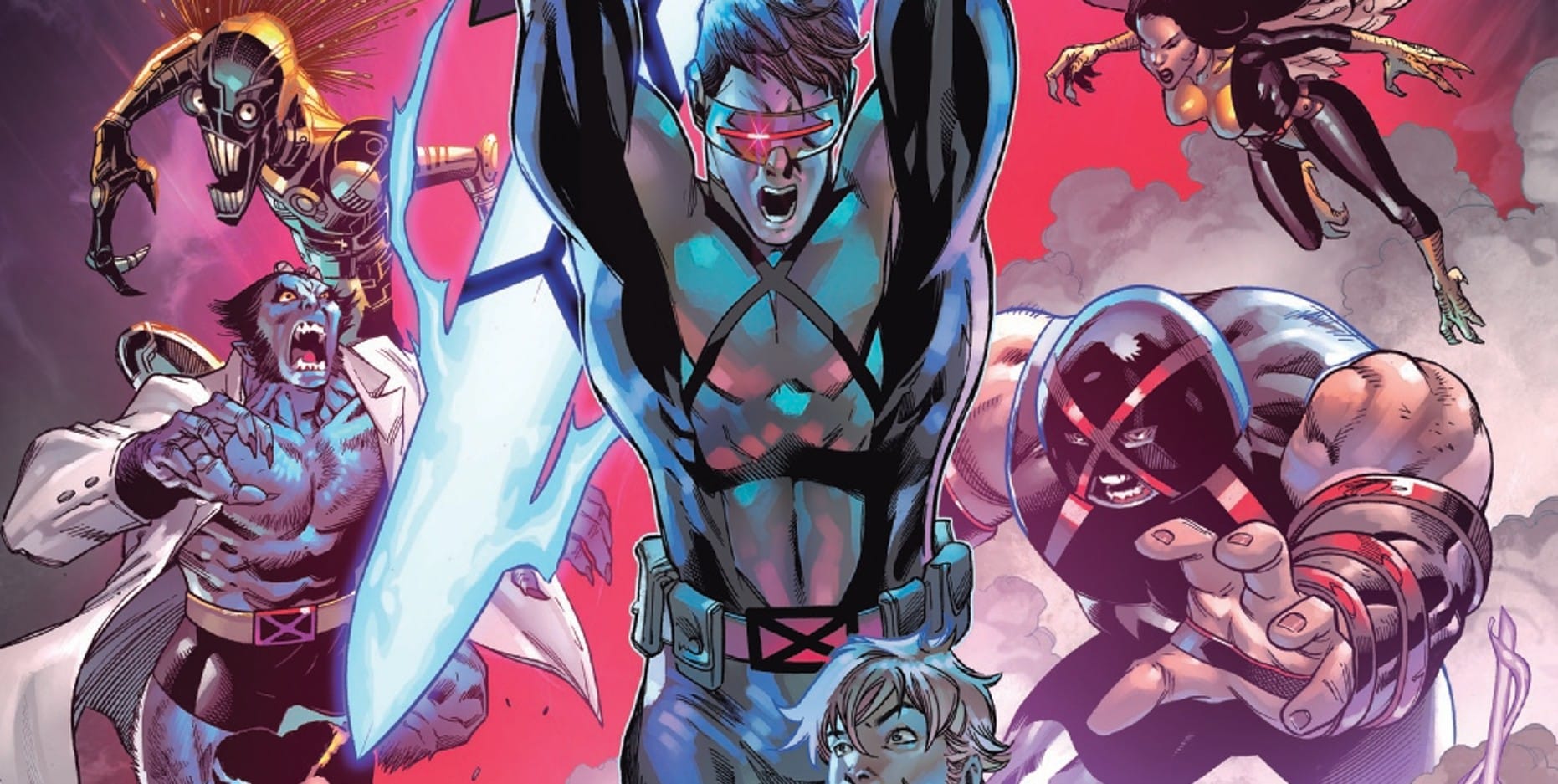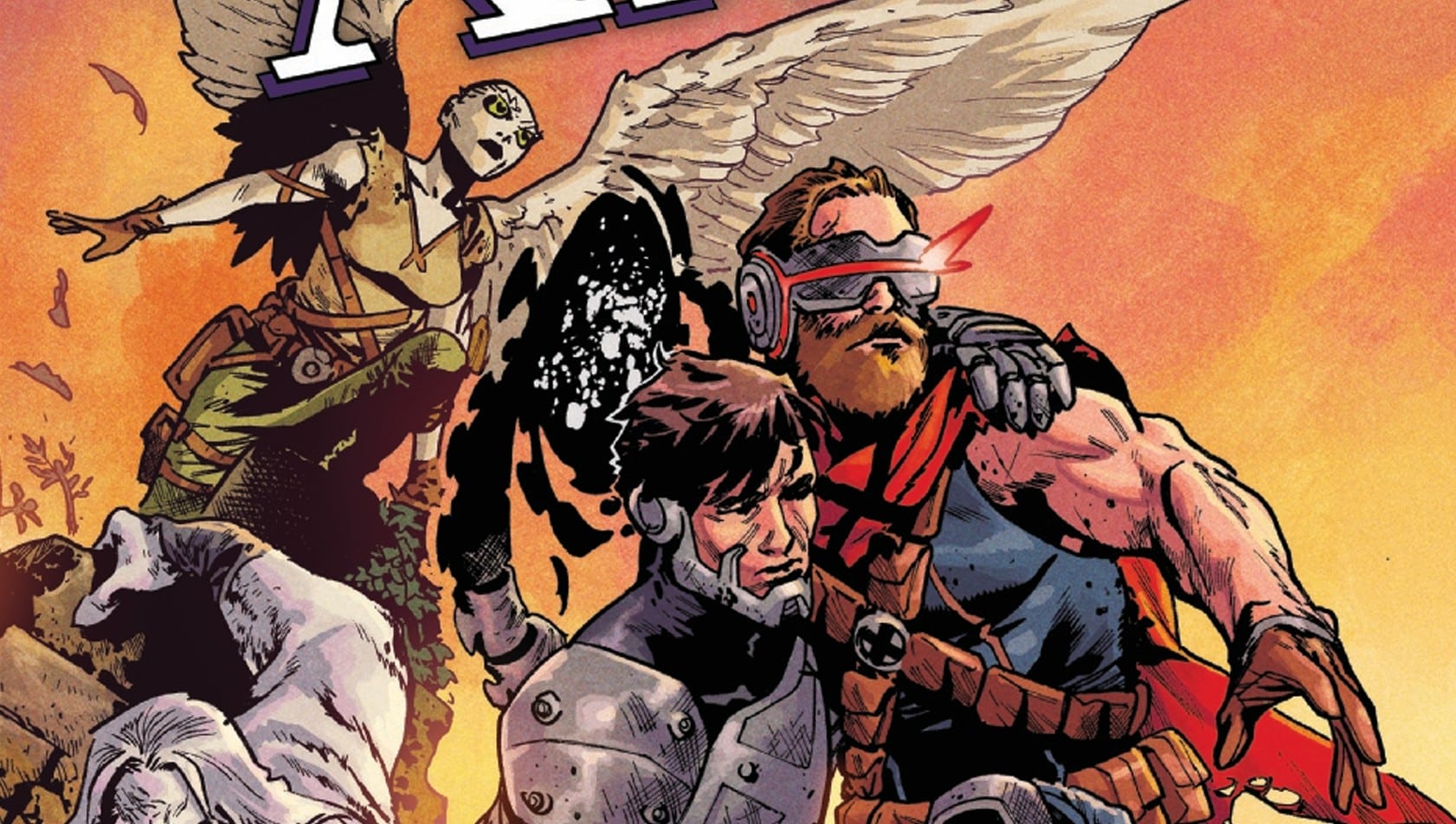Kamala Khan wants to study, and to protect everyone, and to keep her secret identity. Laura Kinney wants to protect the mutants, and to carve up the haters and bad guys. Sophie Cuckoo, Kamala’s new college BFF, wants … what? And what about Anole? Find out in NYX #3, written by Jackson Lanzing and Collin Kelly, drawn by Francesco Mortarino, colored by Raúl Angulo and lettered by Joe Sabino.
The worst canon resets in comics all go back to the exact same “classic” era, the one that casual older readers know from cartoons. The best ones — if they exist; perhaps the least bad ones? — pick odder eras, eras that haven’t been sucked dry by the last three resets, or — better yet — multiple eras, so that the various devotees of various kinds of stories, stars and teams, and settings, ejected from (in this case) the militant Eden of our mutant nation, have somewhere to land, somewhere to go.
I think that’s what we’re seeing in From the Ashes. At least, that’s what I’d like to think we’ve seen, and if that’s right — if every new X-book looks back to a different prior mutant era — what we’ve got in NYX, so far, is a return to Mutant Town: to the years and stories and miniseries, starting with the Grant Morrison run, when mutants in New York had their own niches and neighborhoods and, above all, their own visibility: like real-life immigrant groups, who face varying levels of poverty, bigotry and exclusion but try to make parts of the city their own. That’s not what’s literally happened in this year’s NYX — Mutant Town isn’t a thing — but it’s how the work of NYX Vol. 3 very much feels. As in the Bishop detectives-in-Mutant-Town series. As in NYX Vol. 1 (a lurid comic but a moving one). As in NYX: No Way Home (a much better comic, thanks to Marjorie Liu and Sara Pichelli). NYX, the current run, tells stories about the big city, and about the way that in an urban environment everything — higher education, architecture, media, petty street crime — seems connected to everything else.
They’re also stories about youth. Issue #1 followed Ms. Marvel as she started at Empire State University, made friends with Sophie Cuckoo and — predictably — almost blew her once-again-secret identity as she broke up a discotheque fight and encountered the Krakoan, a pro-mutant terrorist who’s really Hellion (remember him?), working for Empath (alas, I remember him). Issue #2 followed Laura through her flashbacks to NYX Vol. 1, and up through a Dickensy street gang to its crime-syndicate boss-with-tentacles, Mojo (nothing like an election year to make a Mojo story timely).
This issue’s focused on Anole, except that it’s not, because Anole makes a meh focus for stories: He just wants to chill, and tend bar, and avoid big decisions, and maybe find a new mutant boyfriend. He’s not tending bar anymore, because his old employer ditched him in a fit of anti-mutant bigotry after the fight in issue #1. He’s just kind of hanging out, and dressing in fall colors, with a maroon scarf. Like Chamber. So of course he’s going to attend the mourning-slash-protest Kamala organizes in memory of yet another X-gene carrier killed by anti-mutant protest groups. The demonstrators face off with counter-protesters, and people yell, and Kamala’s brother shows up with his bigoted cousin, and Sophie Cuckoo “convinces” them to go away. … It’s a story you’ve read before, if you’ve read X-books before, but it’s set apart by Mortarino and Angulo’s energy in rendering the semi-scuzzy, girders-and-gutters, gas station foreground, skyscraper background, elements of New York. I think we’re in DUMBO, or Red Hook, but I can’t be sure (I do not want to be sure).
New York City history doesn’t confine itself to buildings and tunnels, parks and reservoirs: It’s a history about groups of people, coming together for food or love or politically motivated violence. Not for the first time, the mutants’ public mourning looks an awful lot like public acts of mourning for the queer dead in the pre-treatment era of AIDS, the age of ACT-UP, and also like the public acts of mourning for murdered trans people today. “His name was Shay,” Kamala tells Anole. “But he could have been any of us.” We’re only a few squares away from “Say her name,” and from the ill-advised homage to trans remembrance that got Matthew Rosenberg in trouble in 2019 (and got me to write a poem). But those squares seem crucial: We’re seeing mutants mourning their own, just a few months in Marvel time (if that) after the days when (as Anole says) there were no mutant funerals. It’s enough of a comedown, honestly, that I’m hoping the story can build us back up — but we’re only on issue #3, and we’re reading a book about city life in all its gritty, satisfying intricacies — if you want hope, maybe you should be reading Exceptional X-Men. (Honestly, you should be reading Exceptional. But also this one.)
When you want more of the city — and this book wants to drink in so much of the city — you don’t climb the skyscrapers first. You go underground, and so we do, to the revivified, reinvigorated Morlocks, who want to tell Anole that’s where he belongs. Again, the story’s just fine, maybe overfamiliar, but it’s worth your time because it looks great. Not gross and icky, like many of the original Morlocks, and not glamorous, but great: like weird-aliens great. Like a comic book convention in the Shi’ar empire, or maybe a page from Keith Giffen’s Legion of Super-Heroes. One Morlock looks like a bipedal, six-foot-tale axolotl. Others look like refugees (they may be, literally, refugees) from the Krakoa-era Excalibur’s Otherworld. If you’re looking for mutant community that extends beyond an elite super-team, sworn to protect etc. etc., the Morlocks have you covered, and more than anything else in the new era they preserve the Krakoan ethos, too: “Now let us walk our brother home.” (Better yet: They’re into script preservation. Get your Krakoan alphabet card out for this one.)
More than any X-book in over a decade, and even more than NYX Vols. 1 and 2, Lanzing and Kelly have scripted a New York City book, with New York City history, New York as violence, New York as safety, New York as ambiguous site for outcasts, New York as the city where you never know all about what’s going on, under your feet, down the block, or 50 stories straight up. Ms. Marvel, who lives in Jersey City, draws a line under the goal when she tells Sophie Cuckoo that she can take the PATH train home: “I think I’ve had enough New York for today.”
Oh, and Sophie Cuckoo is not to be trusted. Phooey. At least she’s not the mayor of New York.

X-traneous thoughts
- Anything with Kamala Khan involved ends up earnest, and hopeful, and explicitly political, even if the world falls down around her. The best bit of dialogue in this issue has her declaiming, while smashing two Purifiers’ weapons together, “Gun regulation now!”
- To which Sophie: “Are you just shouting political slogans?”
- Kamala: “Look, I’m too angry to quip, OK?”
- Lanzing and Kelly understand what names this version of Laura Kinney takes. And why. And where. “Even Laura’s here,” Kamala says at the mourning/protest. “And she’s even not making anyone call her by her codename.” That is, she’s got two names: Laura, and Wolverine.
- The Morlocks have laid out their dwellings under New York to resemble Krakoa, down to the many yellow circles — stage lamps? — resembling discs in the Krakoan island-tree.
Buy NYX #3 here. (Disclaimer: As an Amazon Associate, ComicsXF may earn from qualifying purchases.)
Stephanie Burt is Professor of English at Harvard. Her podcast about superhero role playing games is Team-Up Moves, with Fiona Hopkins; her latest book of poems is We Are Mermaids. Her nose still hurts from that thing with the gate.






